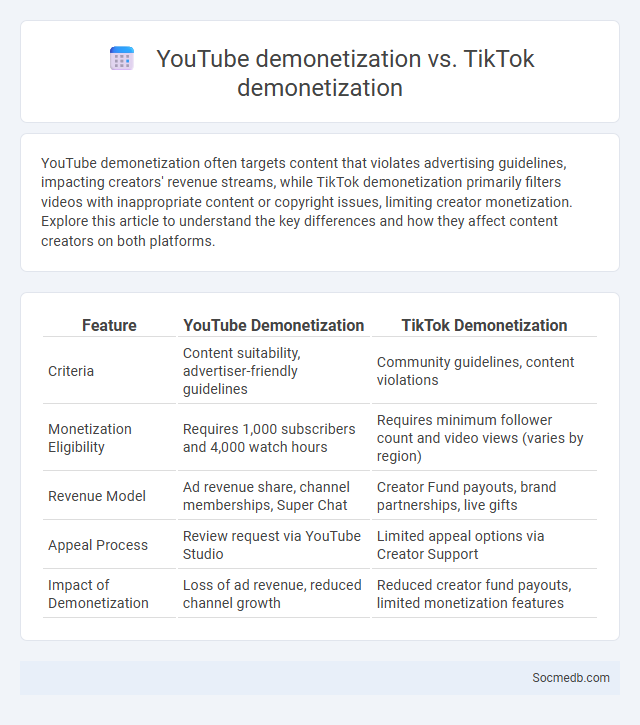
Photo illustration: YouTube demonetization vs TikTok demonetization
YouTube demonetization often targets content that violates advertising guidelines, impacting creators' revenue streams, while TikTok demonetization primarily filters videos with inappropriate content or copyright issues, limiting creator monetization. Explore this article to understand the key differences and how they affect content creators on both platforms.
Table of Comparison
| Feature | YouTube Demonetization | TikTok Demonetization |
|---|---|---|
| Criteria | Content suitability, advertiser-friendly guidelines | Community guidelines, content violations |
| Monetization Eligibility | Requires 1,000 subscribers and 4,000 watch hours | Requires minimum follower count and video views (varies by region) |
| Revenue Model | Ad revenue share, channel memberships, Super Chat | Creator Fund payouts, brand partnerships, live gifts |
| Appeal Process | Review request via YouTube Studio | Limited appeal options via Creator Support |
| Impact of Demonetization | Loss of ad revenue, reduced channel growth | Reduced creator fund payouts, limited monetization features |
Understanding Demonetization: A Digital Era Overview
Demonetization on social media refers to the removal or restriction of monetization features, such as ad revenue, sponsorships, or donations, often due to policy violations or content sensitivity. Platforms like YouTube, Facebook, and Instagram enforce these rules to maintain community standards and advertiser trust, impacting creators' income streams significantly. Understanding these guidelines enables you to navigate content creation strategically, ensuring your work remains eligible for monetization.
The Mechanics of YouTube Demonetization
YouTube demonetization occurs when videos are flagged by automated algorithms or manual reviewers for violating community guidelines or advertiser-friendly content policies, resulting in restricted or removed monetization. Key factors include controversial topics, excessive profanity, or sensitive subjects that advertisers avoid, impacting creators' revenue streams. Understanding YouTube's Content ID system, appeal processes, and policy updates is essential for creators aiming to maintain consistent ad income.
TikTok Demonetization: How It Works
TikTok demonetization occurs when the platform restricts creators' ability to earn revenue from their content due to violations of community guidelines or copyright policies. This process involves reducing or eliminating access to features such as the Creator Fund, live gifts, or brand partnerships, significantly impacting a creator's income stream. Understanding TikTok's algorithm and adhering to content standards is crucial for maintaining monetization privileges and sustaining long-term earnings on the platform.
Comparing the Policies: YouTube vs TikTok
YouTube enforces a comprehensive content policy emphasizing copyright compliance, hate speech restrictions, and detailed community guidelines targeting misinformation, while TikTok's policies highlight safety for younger users, rapid content moderation, and stricter rules on nudity and harassment. Both platforms use automated systems alongside human moderators, yet YouTube's established monetization rules influence its content enforcement more strongly compared to TikTok's focus on viral trends and algorithmic content surfacing. The contrast in their policies reflects YouTube's mature ecosystem prioritizing creator accountability versus TikTok's emphasis on engaging, short-form multimedia within a younger, fast-paced user base.
Core Reasons Behind Content Demonetization
Content demonetization on social media often occurs due to violations of platform policies, including inappropriate language, copyrighted material, or sensitive topics. Algorithms prioritize advertiser-friendly content, leading to reduced revenue potential for posts deemed controversial or unsuitable for brand-safe environments. Understanding these core reasons helps You create compliant, monetizable content that maintains steady visibility and income.
Impact on Creators: Monetization Losses
Social media platform algorithm changes and stricter content policies have led to significant monetization losses for creators, reducing revenue streams like ad earnings and brand partnerships. Creators face increased challenges in maintaining follower engagement due to reduced content visibility and unpredictable platform regulations. These financial impacts threaten the sustainability of independent content creation, pushing many to seek alternative income sources or platforms.
Algorithmic Detection vs Manual Review
Algorithmic detection leverages machine learning models and natural language processing to automatically identify harmful or inappropriate content in real-time, ensuring faster response times across vast volumes of social media posts. Manual review involves trained moderators who assess flagged content for context, nuance, and intent, making judgment calls that algorithms might miss. To optimize your social media safety, platforms often combine both approaches to balance efficiency with accuracy and reduce false positives or negatives.
Navigating Appeals and Monetization Reinstatement
Navigating appeals for social media account reinstatement requires a clear understanding of platform policies and submitting detailed evidence supporting compliance. You should emphasize adherence to community guidelines and provide transparent communication to increase the chances of successful monetization reinstatement. Leveraging platform-specific tools and expert advice can further enhance the effectiveness of your appeal process.
Community Guidelines and Brand Safety
Social media platforms enforce Community Guidelines to ensure respectful interactions and protect users from harmful content, thereby maintaining a safe online environment. Brand Safety measures help advertisers avoid association with inappropriate or controversial content, preserving brand reputation and increasing trust among target audiences. Effective adherence to these policies enhances user experience and maximizes marketing impact across social channels.
Long-Term Effects on Content Creation and Revenue
Social media platforms have transformed content creation by encouraging continuous innovation and audience engagement, which directly influences your brand's long-term revenue streams. Algorithm changes and evolving user preferences necessitate adaptive content strategies to maintain visibility and monetization opportunities over time. Sustainable success depends on understanding data analytics and consistently delivering valuable content that builds loyal communities and drives steady income.
 socmedb.com
socmedb.com